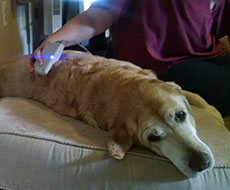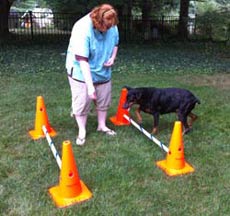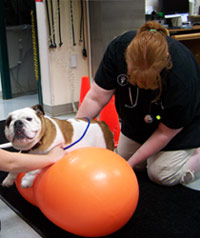Services
Pet Rehabilitation
 Pet Rehabilitation is a rapidly growing field in veterinary medicine. Employing Pet Rehabilitation techniques in your pet's daily care can help to promote physical fitness and prolong his or her quality of life.
Pet Rehabilitation is a rapidly growing field in veterinary medicine. Employing Pet Rehabilitation techniques in your pet's daily care can help to promote physical fitness and prolong his or her quality of life.
Frequently Asked Questions
What is Pet Rehabilitation?
What does Pet Rehabilitation entail?
How do I determine if my pet needs Rehabilitation?
Who can provide Pet Rehabilitation services?
How do we get started?
What is Pet Rehabilitation?
Canine and feline rehabilitation employs the same techniques used in human physical therapy to achieve one or more of the following goals:
- Speed recovery from injury or surgery
- Increase mobility and flexibility
- Improve endurance and agility
- Decrease pain
- Promote weight loss
- Maintain function and prevent further problems
- Enhance quality of life
What does Pet Rehabilitation entail?
 A variety of modalities may be used in your pet's treatment plan including: massage, stretching, neuromuscular electrical stimulation, therapeutic laser or ultrasound, and home exercise programs. Not all therapies are best for each pet and a personalized rehabilitation plan will be made for your companion. Pet Rehabilitation may also be combined with acupuncture, nutritional counseling, and pain management protocols to help ensure the best quality of life for your pet.
A variety of modalities may be used in your pet's treatment plan including: massage, stretching, neuromuscular electrical stimulation, therapeutic laser or ultrasound, and home exercise programs. Not all therapies are best for each pet and a personalized rehabilitation plan will be made for your companion. Pet Rehabilitation may also be combined with acupuncture, nutritional counseling, and pain management protocols to help ensure the best quality of life for your pet.
How do I determine if my pet needs Rehabilitation?
Most pets can benefit from some form of rehabilitation. Some common indications include:
Orthopedic
- Joint surgeries
- Arthritis
- Sports injuries
- Fracture repairs
- Tendon and ligament repairs (i.e. torn cruciate ligaments)
- Hip and elbow dysplasia
 Neurologic
Neurologic
- Post-operative spinal or disc surgeries
- Non-surgical intervertebral disc disease
- Wobbler's syndrome
- Uncoordinated movement (ataxia)
- Peripheral nerve injuries
- Degenerative nerve disease
General
- Chronic pain
- Aging (weakness, stiffness, arthritis)
- Obesity/weight reduction and maintenance
- Strength and fitness training for canine athletes and working dogs
Who can provide Pet Rehabilitation services?
Only a veterinarian or physical therapist that has received training in pet rehabilitation can oversee cases. Licensed Veterinary Technicians and Physical Therapy Assistants that have received training in pet rehabilitation can help to care for patients under the supervision of a veterinarian or physical therapist. At Wholistic Paws, Dr. Krisi Erwin, Certified Canine Rehabilitation Therapist (CCRT) directs our program. She earned her certificate through the Canine Rehabilitation Institute in 2009. She is also a Certified Veterinary Acupuncturist (CVA).
How do we get started?
 Speak with your regular veterinarian about rehabilitation. Working with you and your veterinarian, we will be happy to schedule your first appointment. During your initial visit, Dr. Erwin will ask you pertinent medical questions and will perform a thorough examination on your pet's gait, range of motion, strength, mobility, and pain. From this information, she will create a treatment plan that is tailored to your pet's needs and which will return your companion to optimal function. The treatment plan may include a written, at-home exercise schedule. Your involvement and participation can be crucial to your companion's rehabilitation! We will do our best to provide clear, consistent communication with you and your veterinarian to make sure that all parties are involved in making therapeutic decisions for your pet. Call and schedule your appointment today!
Speak with your regular veterinarian about rehabilitation. Working with you and your veterinarian, we will be happy to schedule your first appointment. During your initial visit, Dr. Erwin will ask you pertinent medical questions and will perform a thorough examination on your pet's gait, range of motion, strength, mobility, and pain. From this information, she will create a treatment plan that is tailored to your pet's needs and which will return your companion to optimal function. The treatment plan may include a written, at-home exercise schedule. Your involvement and participation can be crucial to your companion's rehabilitation! We will do our best to provide clear, consistent communication with you and your veterinarian to make sure that all parties are involved in making therapeutic decisions for your pet. Call and schedule your appointment today!

